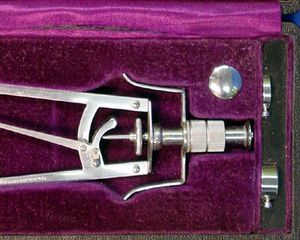 Hjalmar A. Schiotz (1850-1927) was the first professor of ophthalmology in Norway. He studied in Paris with Javal where they worked on a ophthalmometer to measure the curvature of the cornea. Schiotz then took the position in Oslo where he spent three years working on his indentation tonometer.
Hjalmar A. Schiotz (1850-1927) was the first professor of ophthalmology in Norway. He studied in Paris with Javal where they worked on a ophthalmometer to measure the curvature of the cornea. Schiotz then took the position in Oslo where he spent three years working on his indentation tonometer.
He introduced it during a meeting of the Norwegian Medical Society on May 12, 1905.
The Schiotz tonometer was not the first of its kind but it quickly became the most clinically useful. After its introduction, the Schiotz tonometer was the most widely used in studying glaucoma.
Glaucoma itself was known as far back as Hippocrates. Early physicians noted the disease merely as the pupil changing to a blue or green color, which was described as “green waters” or “gleaming”. In 1622 Richard Banister of England published his observation that the condition was associated with a hardening of the eye. His observations, however, wouldn’t become universally accepted as a diagnosis for nearly 200 years.
Between 1818 and 1826, three papers were published all concurring with Banister’s initial finding. By the mid-1800s, ophthalmologists were estimating intraocular pressure by pushing on the eye with their fingers, which became a crucial clinical skill. The first tonometer, or instrument to measure intraocular pressure, was created in the lab of Frans Cornelis Donders (1818-1889) between 1863 and 1868. Improvements to the instrument occurred in 1884 after the introduction of topical anesthesia. First was the Maklakoff applanation tonometer in 1892 and finally Schiotz’s instrument in 1905.